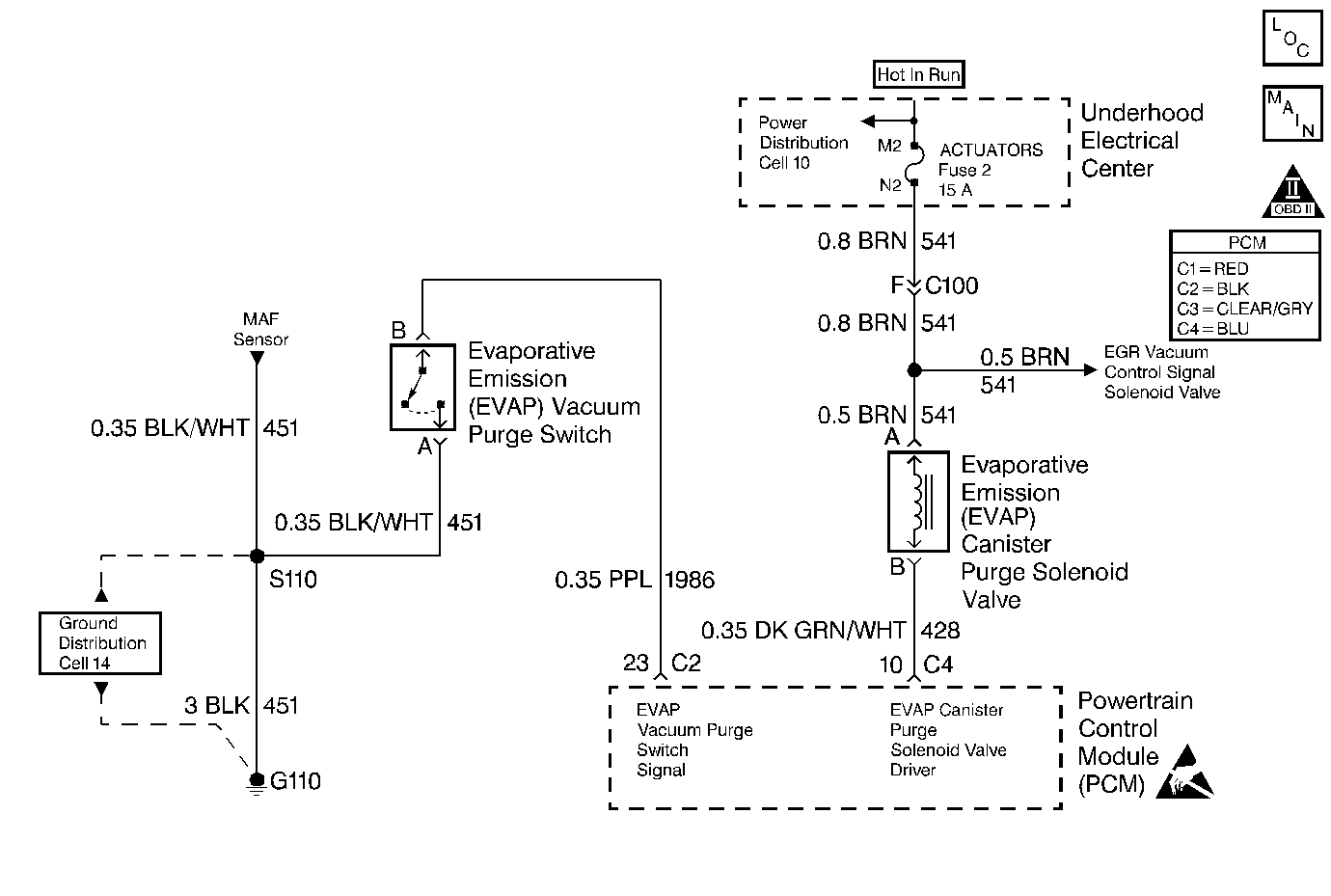
Circuit Description
The EVAP vacuum switch is a normally closed switch connected to ground, mounted in the vacuum line between the EVAP canister and the EVAP solenoid. 12 volts is supplied to the switch through a pull-up resistor in the PCM. When the PCM commands the EVAP canister purge solenoid valve open (purge ON) and engine vacuum draws the evaporative emissions from the canister, the EVAP vacuum switch opens (signal voltage high) providing feedback to the PCM that the EVAP system is operating. When the PCM commands purge OFF, the EVAP vacuum switch closes (signal voltage low) confirming purging has ceased.
Conditions for Setting the DTC
| • | DTCs P0100, P0101, P0102, P0103, P0106, P0323, P0325, P0327, P0332, P0335, P0336, P0372, P0400, P0403, P0410, P0412, P0420, P0430,P0441, P0443, P0500, P0502, P0503, P0506, P0507, P0530, P0531, P0719, P0758, P1415, P1642, P1652 not set. |
| • | ECT less than 115°C (239°F) |
| • | IAT greater than 3°C (37°F) |
| • | Engine speed between 800 and 3000 RPM |
| • | TP Angle between 2% and 50% |
| • | MAP between 33 and 77 kPa |
| • | BARO greater than 77 kPa |
| • | Purge duty cycle above 60% |
| • | The PCM detects low signal voltage on the EVAP vacuum switch signal circuit when the PCM is commanding purge ON. |
| • | Fault present for 5 seconds |
Action Taken When the DTC Sets
| • | The PCM will illuminate the Malfunction Indicator Lamp (MIL) on the second consecutive drive trip that the diagnostic runs and fails. |
| • | The PCM will record operating conditions at the time the diagnostic fails. The first time the diagnostic fails, this information will be stored in Failure Records. If the diagnostic reports a failure on the second consecutive drive trip, the operating conditions at the time of failure will be written to Freeze Frame and the Failure record will be updated. |
Conditions for Clearing the MIL/DTC
| • | The PCM will turn the MIL OFF after three consecutive drive trips that the diagnostic runs and does not fail. |
| • | A last test failed (Current DTC) will clear when the diagnostic runs and does not fail. |
| • | A History DTC will clear after forty consecutive warm-up cycles, if no failures are reported by this or any other emission related diagnostic. |
| • | PCM battery voltage is interrupted. |
| • | Using a Scan tool. |
Diagnostic Aids
Before replacing any components, visually/physically check for the following:
| • | Mis-routed harness. |
| • | Rubbed through wire insulation. |
| • | Broken wire inside the insulation. |
| • | Kinked or damaged vacuum hoses. |
| • | Physically damaged system components. |
| • | Inspect components and vacuum lines for traces of carbon or other contaminants. The presence of foreign material may be causing a restriction in the system or preventing the solenoid valve from closing properly. Either condition may cause a DTC to set. |
For intermittents, refer to Symptoms .
Test Description
Number(s) below refer to step numbers on the diagnostic table.
Step | Action | Value(s) | Yes | No | ||||
|---|---|---|---|---|---|---|---|---|
1 | Was the Powertrain On-Board Diagnostic (OBD) System Check performed? | -- | ||||||
|
Important: If DTC P0443 is set, refer to that DTC first.
Does the scan tool indicate the EVAP vacuum switch has No Purge? | -- | |||||||
3 |
Does the scan tool indicate Purge when the solenoid is commanded ON? | -- | Go to Diagnostic Aids | |||||
4 |
Does the vacuum gauge indicate close to normal engine vacuum when the solenoid is commanded ON? | -- | ||||||
5 | Disconnect the EVAP vacuum switch harness connector. Does the scan tool indicate Purge? | -- | ||||||
6 |
Does the DVM indicate infinite resistance? | -- | ||||||
7 | Disconnect the vacuum harness from the EVAP canister purge solenoid valve and connect a vacuum gauge to the manifold side of the vacuum harness. Is normal manifold vacuum indicated? | -- | ||||||
8 |
Is vacuum indicated when the EVAP canister purge solenoid valve is ON? | -- | ||||||
9 | Replace EVAP vacuum switch, refer to Evaporative Emission Purge Vacuum Switch Replacement . Refer to Evaporative Emission System Cleaning for cleaning procedure of EVAP system before replacing the EVAP vacuum switch. Is the action complete? | -- | -- | |||||
10 | Check connections at the PCM. Was a problem found and corrected? | -- | -- | |||||
11 |
Important:: Replacement PCM must be programmed. Refer to Powertrain Control Module Replacement/Programming . Replace the PCM. Is the action complete? | -- | -- | |||||
12 | Repair signal circuit shorted to ground. Is the action complete? | -- | -- | |||||
13 | Check for the following conditions:
Was a problem found and corrected? | -- | ||||||
14 | Repair restricted, kinked or leaking hose between the EVAP solenoid and the EVAP vacuum switch, Refer to Evaporative Emission System Cleaning for cleaning procedure of EVAP system. Is the action complete? | -- | -- | |||||
15 | Replace the EVAP solenoid, refer to Evaporative Emission Canister Purge Solenoid Valve Replacement . Refer to Evaporative Emission System Cleaning for cleaning procedure of EVAP system before replacing the EVAP solenoid. Is the action complete? | -- | -- | |||||
16 |
Does the scan tool indicate that this test ran and passed? | -- | ||||||
17 | Using the scan tool, select Capture Info, Review Info. Are any DTCs displayed that have not been diagnosed? | -- | Go to the applicable DTC table | System OK |
